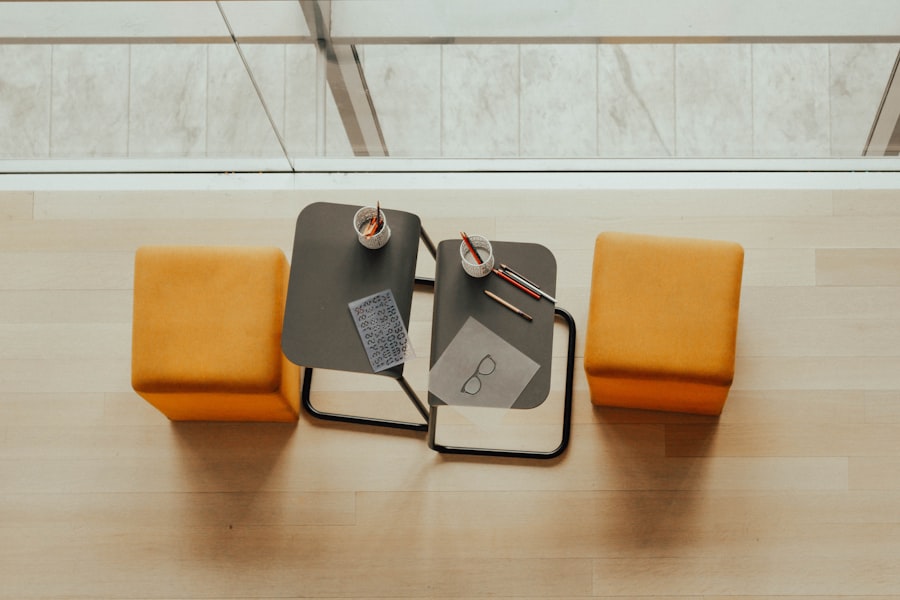Selecting the appropriate size and shape for furniture, particularly desks and chairs, is crucial for creating a functional workspace. The dimensions of your furniture should align with the available space in your office or home environment. A desk that is too large can overwhelm a small room, making it feel cramped and uncomfortable, while a desk that is too small may not provide enough surface area for your work needs.
When considering size, it’s essential to take into account not only the physical dimensions of the furniture but also the height. A desk that is too high or too low can lead to poor posture and discomfort over extended periods of use. Therefore, measuring your space and understanding your personal requirements is the first step in making an informed decision.
The shape of your desk can also significantly impact both functionality and aesthetics. Traditional rectangular desks are versatile and fit well in most spaces, but L-shaped or corner desks can maximize workspace in smaller areas by utilizing corners effectively. Additionally, standing desks have gained popularity for their health benefits, allowing users to alternate between sitting and standing throughout the day.
The choice of shape should also consider how you work; for instance, if you often collaborate with others, a round or oval table may facilitate better communication. Ultimately, the right size and shape will not only enhance your productivity but also contribute to a more organized and visually appealing workspace.
Key Takeaways
- When choosing the right size and shape for your workspace, consider the available space and the type of work you will be doing.
- Ergonomic design is crucial for comfort and health, so look for features such as adjustable height and lumbar support in your office furniture.
- Storage solutions and organization are essential for keeping your workspace tidy and efficient, so prioritize furniture with built-in storage options.
- Cable management and accessibility are important for maintaining a clean and organized workspace, so look for furniture with integrated cable management systems.
- Personalization and aesthetics can enhance your workspace and make it feel more inviting, so consider furniture that allows for customization and reflects your personal style.
Ergonomic Design for Comfort and Health
Key Elements of Ergonomic Design
Key elements of an ergonomic setup include adjustable chairs that support the natural curve of the spine, desks that allow for proper arm positioning, and monitor stands that ensure screens are at eye level.
Benefits of Ergonomic Furniture
Investing in ergonomic furniture can significantly reduce the risk of musculoskeletal disorders, which are common among individuals who spend extended periods sitting at a desk. Furthermore, ergonomic designs often incorporate features such as lumbar support and adjustable armrests, which can be tailored to individual preferences, promoting better posture and overall comfort.
Enhancing Productivity and Well-being
A well-designed environment reduces fatigue and increases focus, allowing individuals to work more efficiently. By prioritizing ergonomic design in your workspace, you not only invest in your physical health but also create an environment conducive to productivity and creativity.
Storage Solutions and Organization

Effective storage solutions are essential for maintaining an organized workspace that fosters productivity. Clutter can lead to distractions and decreased efficiency, making it vital to implement systems that keep items neatly stored yet easily accessible. Desks with built-in drawers or shelves can help manage paperwork, office supplies, and personal items without taking up additional floor space.
Additionally, vertical storage options such as wall-mounted shelves or pegboards can maximize storage capacity while keeping surfaces clear. The key is to find a balance between accessibility and organization; items that are frequently used should be within easy reach, while less frequently accessed items can be stored away. Moreover, organization extends beyond just physical storage; it also involves creating a system that works for you personally.
This could mean categorizing documents by project or using color-coded folders for easy identification. Digital organization is equally important in today’s tech-driven world; utilizing cloud storage solutions or project management software can streamline workflows and reduce physical clutter. By investing time in developing effective storage solutions and organizational strategies, you create a workspace that not only looks tidy but also enhances your ability to focus and accomplish tasks efficiently.
Cable Management and Accessibility
In an age where technology plays a pivotal role in our daily tasks, effective cable management has become increasingly important. A tangle of cords can not only create visual chaos but also pose safety hazards, such as tripping or damage to devices. Implementing cable management solutions—such as cable trays, clips, or sleeves—can help keep cords organized and out of sight.
These tools allow for a cleaner aesthetic while ensuring that cables are easily accessible when needed. Additionally, considering the placement of power outlets during the design phase can further enhance accessibility; having outlets within reach reduces the need for long extension cords that can contribute to clutter. Accessibility is not just about managing cables; it also involves ensuring that all necessary equipment is within easy reach.
This includes positioning monitors at eye level, keeping frequently used tools close at hand, and ensuring that power sources are conveniently located. A well-organized workspace with effective cable management allows for smoother transitions between tasks and minimizes interruptions caused by searching for chargers or untangling cords. By prioritizing both cable management and accessibility in your workspace design, you create an environment that promotes efficiency and reduces frustration.
Personalization and Aesthetics
Personalization plays a significant role in creating a workspace that feels inviting and inspiring. When individuals have the opportunity to infuse their personality into their environment, they are more likely to feel comfortable and motivated. This could involve selecting furniture that reflects personal style—whether modern, rustic, or eclectic—or incorporating decorative elements such as artwork, plants, or personal mementos.
The aesthetic appeal of a workspace can greatly influence mood and productivity; a well-decorated area can evoke feelings of creativity and positivity. Moreover, personalization extends beyond mere decoration; it encompasses creating a space that aligns with one’s work habits and preferences. For instance, some individuals may thrive in bright, open spaces filled with natural light, while others may prefer a more subdued atmosphere with softer lighting.
Incorporating elements such as adjustable lighting options or soundproofing materials can further enhance comfort levels based on individual needs. Ultimately, a personalized workspace not only reflects one’s identity but also fosters an environment conducive to creativity and productivity.
Multi-functionality and Versatility

Adapting to the Modern Workspace
In today’s fast-paced world, multi-functionality has become a key consideration when designing workspaces. As remote work becomes more prevalent, individuals often require furniture that serves multiple purposes to maximize limited space effectively. For example, desks that can convert from sitting to standing positions cater to varying work styles while promoting health benefits associated with movement throughout the day.
Versatile Furniture for Changing Needs
Furniture pieces like foldable tables or modular shelving units allow for easy reconfiguration based on changing needs or tasks. Versatility also extends to storage solutions; furniture that incorporates hidden compartments or dual-purpose designs can help maintain an organized environment without sacrificing style or functionality. For instance, ottomans with storage capabilities can serve as both seating and a place to store office supplies or personal items.
Maximizing Efficiency and Comfort
By embracing multi-functionality in workspace design, individuals can create adaptable environments that evolve alongside their work habits while maximizing efficiency and comfort. This approach enables individuals to stay organized, focused, and productive, ultimately leading to a more successful and fulfilling work experience.
Creating a Sustainable Workspace
By investing in multi-functional furniture, individuals can reduce waste and minimize the need for frequent replacements. This sustainable approach to workspace design not only benefits the environment but also contributes to a more efficient and cost-effective work environment.
Quality Materials and Durability
The choice of materials used in furniture design significantly impacts both durability and overall aesthetic appeal. High-quality materials not only enhance the longevity of furniture but also contribute to a more polished look in any workspace. For instance, solid wood desks offer timeless elegance while providing robust support for daily use; similarly, metal frames can add a modern touch while ensuring stability.
When selecting materials, it’s essential to consider factors such as wear resistance, ease of maintenance, and environmental impact—sustainable options like bamboo or recycled materials are increasingly popular among eco-conscious consumers. Durability is particularly important in high-traffic areas where furniture is subjected to daily wear and tear. Investing in well-constructed pieces made from quality materials can save money in the long run by reducing the need for frequent replacements.
Additionally, understanding warranties offered by manufacturers can provide peace of mind regarding the longevity of your investment. By prioritizing quality materials in your workspace design, you create an environment that not only looks great but also stands the test of time.
Budget-Friendly Options and Value for Money
Creating an ideal workspace doesn’t have to break the bank; there are numerous budget-friendly options available that offer excellent value for money without compromising on quality or functionality. Shopping during sales events or exploring second-hand stores can yield high-quality furniture at reduced prices. Additionally, many retailers offer affordable alternatives to high-end brands without sacrificing essential features such as ergonomic design or durability.
It’s important to conduct thorough research before making purchases; reading reviews and comparing prices can help identify the best options within your budget. Value for money extends beyond just initial costs; it encompasses long-term benefits such as durability and versatility. Investing in multi-functional furniture may require a higher upfront cost but can ultimately save money by eliminating the need for additional pieces down the line.
Furthermore, considering factors like warranty coverage can provide additional assurance regarding the longevity of your investment. By carefully evaluating budget-friendly options while prioritizing quality and functionality, you can create a workspace that meets your needs without compromising financial stability.
If you’re looking to enhance your workspace with a stylish office table, you might find inspiration in the latest trends and designs featured in an article about office interiors. For more ideas on how to create a functional yet aesthetically pleasing office environment, check out this article on stylish office interior decor. It offers a range of tips and insights into selecting the right furniture and accessories that can transform your office into a more productive and inviting space.
FAQs
What is an office table?
An office table is a piece of furniture designed for use in an office setting. It typically provides a flat surface for working, writing, or using a computer, and may include storage options such as drawers or shelves.
What are the different types of office tables?
There are various types of office tables, including executive desks, computer desks, writing desks, conference tables, and standing desks. Each type is designed to serve a specific purpose and accommodate different work styles.
What materials are office tables made of?
Office tables can be made from a variety of materials, including wood, metal, glass, and laminate. The choice of material often depends on the desired aesthetic, durability, and budget.
What are the important factors to consider when choosing an office table?
When choosing an office table, it’s important to consider factors such as size, shape, storage options, material, and style. Additionally, ergonomic considerations and the specific needs of the user should be taken into account.
How can an office table contribute to a productive work environment?
An office table that is well-designed and suited to the needs of the user can contribute to a productive work environment by providing a comfortable and organized workspace. It can also enhance the overall aesthetic of the office and contribute to a professional atmosphere.


